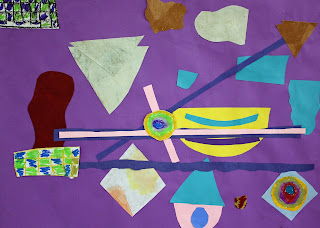The fifth graders are practically professional “curvilinear line-makers” by now. After finishing their line drawing, I challenged students to attempt another line drawing by repeating curvilinear lines and shapes, and then adding color!
Preceding this second drawing, students studied an energetic design principle: movement. We talked about how movement uses the elements of art (like: line, shape, and color) to create visual interest in a piece of artwork. Specifically, we looked at the ever famous “Starry Night,” and how Vincent van Gogh guided our eyes around the entire piece by strategically planning out lines and color to create movement. Students took turns tracing how their eye traveled throughout “Starry Night.” It was interesting to see how many of our eyes took different paths throughout the piece.

Then, after completing the line drawing step, we looked closely into color schemes to add another layer of movement with the element of color. We reviewed complementary colors, and I introduced the students to warm and cool colors. We looked at pictures that had both warm and cool colors, and talked about how warm colors advance on the page, while cool colors tend to recede. Students chose their color scheme (complementary, warm, cool, or warm and cool) to complete their project. Enjoy the results below!











